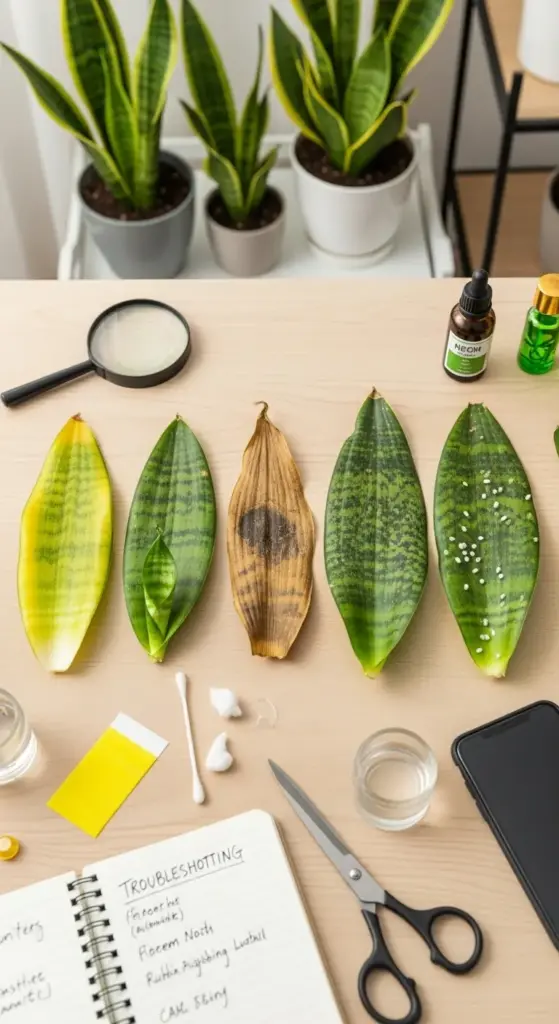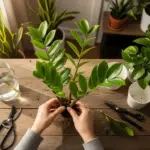6. Troubleshooting Common Problems Like a Pro

Nothing sends me into panic mode faster than spotting something “wrong” with my snake plants. I used to rush to plant forums at 2 AM, frantically googling every yellow spot and brown tip.
Turns out, most “problems” are either totally normal or super easy to fix once you know what you’re looking at. Plant troubleshooting is like being a detective – you just need to know the clues.
Yellow Leaves: The Mystery That Stumps Everyone
Bottom leaves turning yellow is usually completely normal – it’s just the plant shedding old growth to make room for new leaves. I panicked about this for months before learning it’s natural aging.
But yellow leaves starting from the top or middle? That’s your plant screaming about overwatering or root rot. The soil test is your first move here.
Sudden yellowing of multiple leaves often means temperature shock. I’ve seen this happen when plants get moved from warm stores to cold cars in winter.
Gradual yellowing with soft, mushy texture is classic overwatering damage. Stop watering immediately and check those roots – you might need emergency repotting.
Yellow streaks or patches instead of whole leaves usually indicate nutrient deficiency or too much direct sunlight. Move the plant and consider light fertilizing.
Brown Tips: Your Plant’s Stress Signals
Crispy brown tips are almost always about low humidity or water quality issues. I switched to filtered water and the problem disappeared within weeks.
Fluoride and chlorine in tap water build up in leaf tips over time. Let your water sit out overnight or use distilled water for sensitive plants.
Dry indoor air from heating systems causes brown tips faster than anything else. My plants near heat vents always suffered until I moved them.
Brown tips spreading inward means the damage is getting worse. Trim them off with clean scissors – cut at an angle to mimic the natural leaf shape.
Soft, dark brown spots are different from crispy tips – that’s usually fungal infection from too much moisture on the leaves.
Pest Problems and Natural Solutions
Spider mites are tiny but leave telltale webbing on leaves. I missed them for weeks because they’re practically invisible to the naked eye.
A strong shower spray knocks most spider mites right off. I take affected plants to the bathroom and blast them with lukewarm water.
Mealybugs look like tiny cotton balls hiding in leaf crevices. Rubbing alcohol on a cotton swab kills them instantly – I check for these monthly now.
Scale insects appear as small brown bumps stuck to leaves. They’re harder to spot but scrape off easily with a fingernail or soft brush.
Fungus gnats flying around your plant usually mean overwatering issues. Yellow sticky traps catch the adults while you fix the soil moisture problem.
Neem oil spray works for most pest issues, but I dilute it properly and test on one leaf first. Too strong and you’ll burn the plant.
Normal vs. Panic-Worthy Plant Behavior
Slow growth is totally normal for snake plants – they’re not speed demons. I used to think mine were dying when they just weren’t growing fast.
One or two bottom leaves dying per year is natural aging, not a health crisis. New growth from the center means your plant is thriving.
Leaves leaning or spreading happens as plants mature. It’s not a problem unless they’re falling over completely from root issues.
Seasonal growth spurts in spring are normal – don’t panic if your plant suddenly shoots up new growth after months of nothing.
Color changes from bright to darker green usually mean the plant is adapting to lower light conditions. It’s adjustment, not illness.
Emergency Plant Rescue Techniques
Severely overwatered plants need immediate root surgery. Remove from soil, cut away any black or mushy roots, and repot in fresh, dry soil.
Let rescued plants sit without water for at least a week after repotting. I know it feels wrong, but they need time to heal.
Completely dried out plants bounce back surprisingly well. Water thoroughly and wait – don’t panic-water them multiple times in a row.
Broken or damaged leaves should be cut cleanly at the soil line. Don’t leave stubs that can rot and spread problems to healthy parts.
Cold damage from drafts or transport shows up as dark, water-soaked spots. Cut damaged areas immediately to prevent spread.
Fertilizer burn from too much plant food causes brown, crispy edges. Flush the soil with plain water several times to remove excess nutrients.
Repotting shock is real – plants might look sad for weeks after being disturbed. Keep conditions stable and resist the urge to “help” more.
Ready to turn your snake plant knowledge into serious home decor goals? The final section reveals the styling secrets that interior designers use to make snake plants look like expensive statement pieces – including my favorite placement tricks that make any room look professionally designed! ✨









GIPHY App Key not set. Please check settings